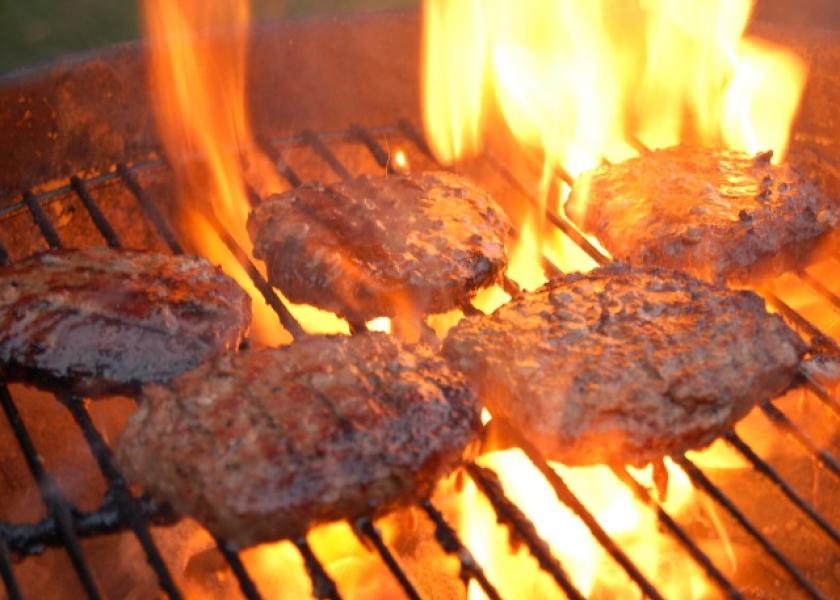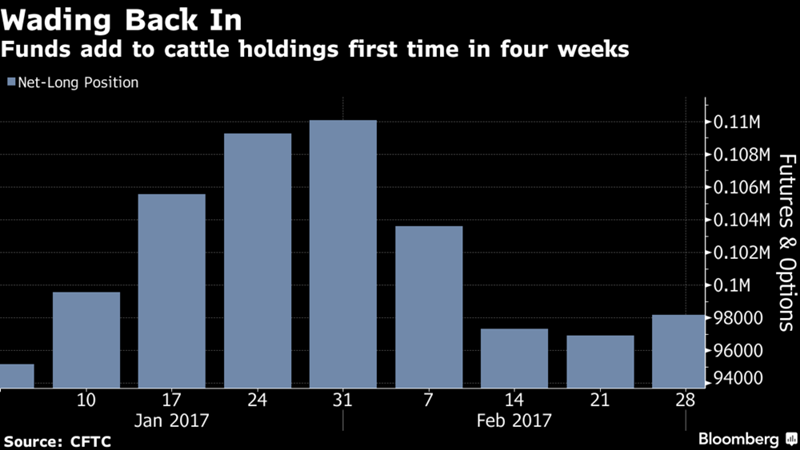Warm Winter Props up Beef Demand

So much for the winter blues. It’s been so balmy across part of the U.S. that Americans have been firing up their grills at a time that’s usually better suited to sipping hot cocoa.
U.S. consumers, buoyed by optimism about the economy as well as record warm temperatures in February, have been buying up burgers like it’s summertime. Beef is on a roll, with wholesale prices rallying to the most expensive since July. It’s surprising since the usual time for outdoor barbecues typically kicks off closer to May.
And it’s not just grilling that’s propping up beef prices. People are getting out the house more often to enjoy the weather, frequenting restaurants and ordering up premium cuts such as steaks. Overseas demand has also risen, with a boom in shipments to countries including Japan and South Korea. All that is chipping away at bigger production and drawing the interest of hedge funds. Money managers added to their bullish bets on cattle for the first time in four weeks.
“We really, in all honesty, haven’t had winter, and it has enabled a lot of grilling options to stay viable,” said Don Close, the vice president of food and agribusiness research at Rabobank International in St. Louis, where he’s seen February temperatures as high as 80 degrees Fahrenheit (27 Celsius). “We’ve got solid movement on the low-priced items and have preserved good clearance on high-end items.”
Winning Streak
The gains for beef prices have boosted the cattle market. Cattle futures traded in Chicago capped a third straight weekly gain, rising 0.9 percent to $1.15975 a pound in the longest winning streak of 2017. The April contract is up about 0.9 percent this year.
Fund managers are positioned for more gains. The cattle net-long position, or the difference between bets on a price increase and wagers on a decline, climbed 1.3 percent to 98,170 futures and options in the week ended Feb. 28, according to U.S. Commodity Futures and Trading Commission data released three days later.
 Money managers add to wagers that cattle futures will rally. © Bloomberg |
Grilling enthusiasts can thank higher-than-normal sea-surface temperatures in the western Atlantic and Gulf of Mexico for the spring-like weather. There were also more winds from the south blowing heat northward. As of Friday, 6,172 records were set for daily high temperatures over the last 30 days across the U.S., according to the National Centers for Environmental Information. In contrast, there were just 281 cold records. The official first day of spring isn’t until March 20.
Prices in the cash-cattle market are so good for the animals that ranchers are “pulling them forward,” or sending them to market rather than fattening them up for longer, Close said. Animals are coming to slaughter lighter, with average weights in the week ended March 4 down about 0.7 percent from a year earlier, government data show. The smaller weights are helping to offset rising weekly slaughter levels, which are running about 8 percent higher than last year.
Still, there are also signs that demand is running stronger than the increased slaughter volumes.
Positive Margins
Margins have turned positive for beef processors. The meatpackers were making $20.05 a head as of March 3, HedgersEdge data show. That compares with losses of as much as $82.85 in January and is the best for this time of year since at least 2014.
Improving macroeconomic environments in the U.S., European Union and China will continue to support beef demand this year, analyst Rajesh Singla of Societe Generale SA said in a Feb. 15 report. American consumer confidence unexpectedly surged last month to the highest level since 2001.
Exports are also eating away at bigger domestic supplies. Volumes in December were 24 percent higher than a year earlier at 116,847 metric tons, a record for the month, according to the most recent data from the U.S. Meat Export Federation.
Still, prices may be getting high enough now to discourage retailers from stocking up. Wholesale beef is already at the most expensive since July. That could mean fewer promotions during the typical springtime boom for beef. And even more cattle are expected to flood the market in the next several months, increasing the likelihood that the rally in prices will stall.
“If you run up the price too soon, it sows seeds of weaker demand and quantity for the traditional grilling season,” said Altin Kalo, an analyst at Manchester, New Hampshire-based Steiner Consulting Group, an economic and commodity-trading adviser. “You run the risk of impacting futures going into post-Easter and Memorial Day,” which in previous years marked the start of the summer barbecue season, he said.







